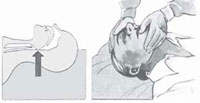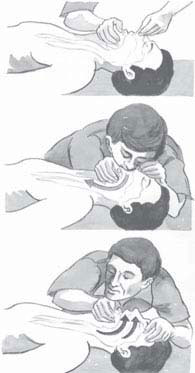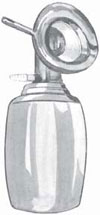First Aid
4. Respiratory Arrest
4.3. Artificial Respiration
Commencing artificial respiration is very simple and can very easily be successful. As time passes, changes take place in the lungs that make it difficult for the casualty to respond well.
To carry out artificial respiration, you have to:
- 1) Keep the person lying on the floor, face up. This is the ideal posture.
- 2) Open the airway. There are different manoeuvres to open the airway, all of which are aimed at placing the person in a position in which his tongue does not impede him from breathing. The most correct method to keep the airway open is by placing one hand on the forehead and the other on the lower jaw and inclining the person’s head backwards, thus producing hyperextension of the neck. The airway may also be kept open by placing an object under the shoulders, thus leaving the head dangling.
- 3) Check the person’s mouth and unclog it of any food remains, dentures, etc., if present.
- 4) Begin respiration: The most widely used method is mouth-to-mouth respiration.

Airway obstructed by the tongue of an unconscious person

To do this correctly, you must seal the person’s nose with one hand, fill your lungs with air, place your mouth over the lips of the injured person and blow slowly (each insufflation should last approximately 2 seconds). Separate your mouth from that of the injured person so that the air can exit and insufflate again after 5 seconds. Remember that you should blow once every 5 seconds in adults.
When the air enters correctly, you will notice that you can empty your lungs without encountering any resistance. The injured person’s chest will rise as air enters. If you blow very quickly, the air will end up in the inured person’s stomach. Insufflation should be slow and sustained.
Children under 7 years of age breathe more quickly than adults. Therefore, the first-aider should blow once every 3 seconds, without totally emptying his lungs of air, as the thoracic capacity of a child is less than that of an adult.
4.4. Other Artificial Respiration methods
Mouth-nose respiration: When there is injury to the mouth or it cannot be opened, artificial respiration may be performed via the injured person’s nose.
To do so, keep the airway open, close the person’s mouth and blow through his nose once every 5 seconds.
Instrumental artificial respiration: An Ambu bag can be used; this is a device consisting of a padded mask that fits over the patient’s face, covering the nose and mouth, which is connected to a plastic pump. If you have one of these devices at your disposal, you should learn how to use it.





